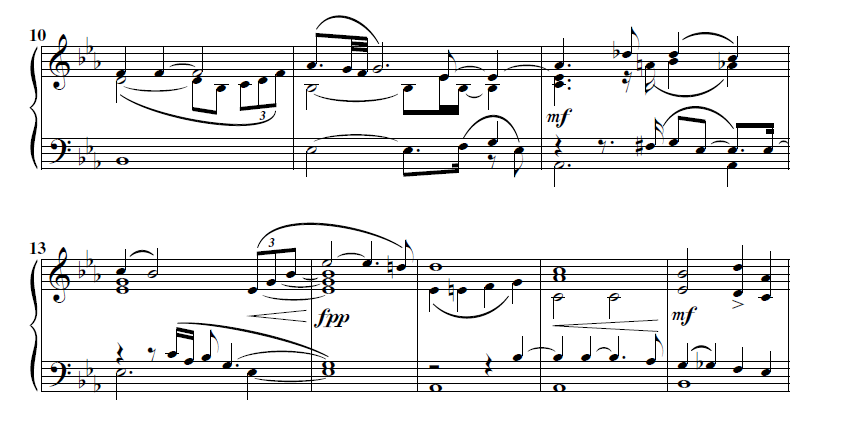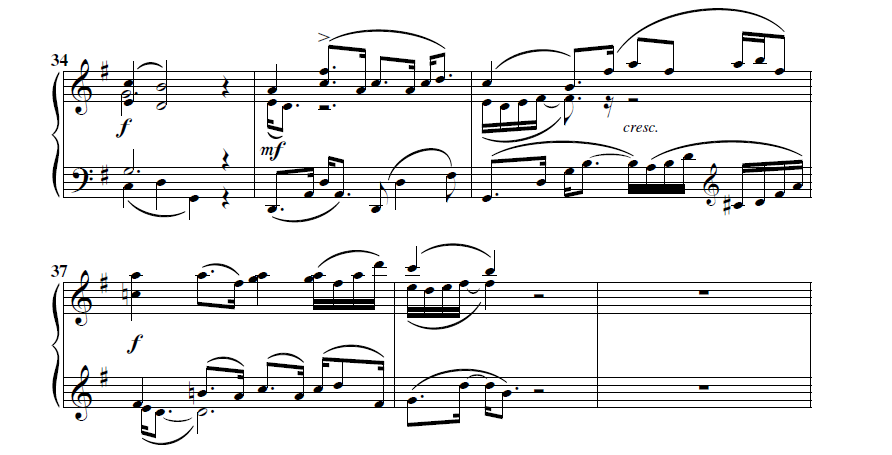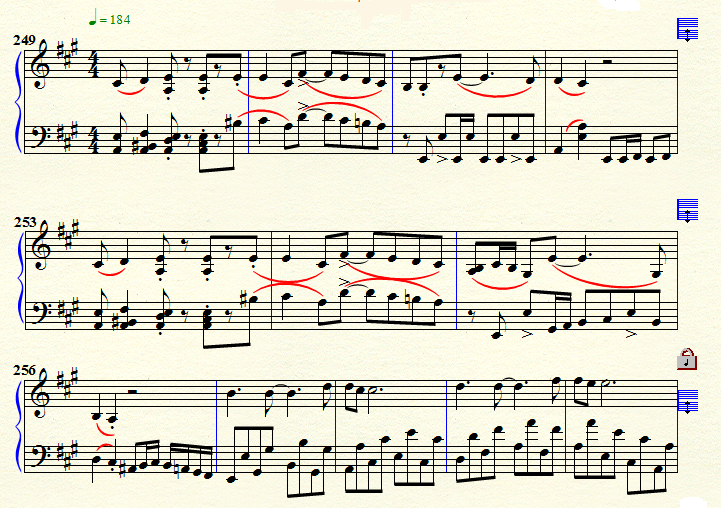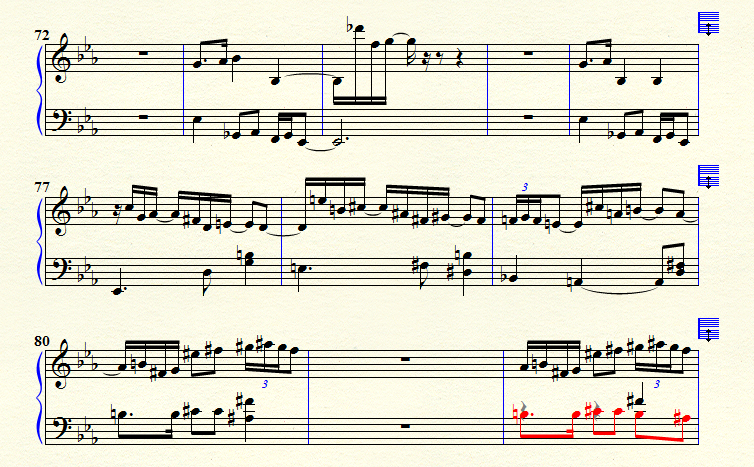
Like a cell dividing


Seeking balance in a chaotic world

In the previous post, I laid out the main theme:

 Followed by variation #1, now with some additional material:
Followed by variation #1, now with some additional material:






So that’s the little forest I’ve wandered into. Where is it going? Is it building toward a climax? Maybe it just wants to wander further afield. Or perhaps it’s time to steer it back to a place that feels like home. Where are you going little baby of mine?
New ideas are popping into my brain, even as I write this. I’m going to go work more on this project, try to find the way out. Stabbing blindly with my sabre through the elephant grass…
By 1890 the world’s ears had rusted shut. Debussy pried them open with a crowbar and poured jazz down the hole.
When Claude Debussy wrote toward the end of the 19th century that “any sounds in any combination and in any succession are henceforth free to be used in a musical continuity,” he probably did not foresee the likes of John Cage or Lawrence Chandler or even Frank Zappa. Yet even if Debussy might have doubted whether these later composers’ experiments could actually be called music, Debussy was a kind of father to them all. His groundbreaking use of harmony announced to the world that anything was acceptable, that composers could literally do whatever they wanted, that any colors were appropriate in any combination. He broke the rules! But more importantly he gave his successors permission to systematically deconstruct the rules to such an extent that they became like the oxidized old Beethoven statue in Bonn, Germany: a memorial to something that was once great.
The 19th century had revealed itself to be a musical landscape in full bloom, with every major genre of classical music reaching its mature peak. With demi-gods like Liszt, Wagner, Chopin, and Brahms at the reins, harmony and form were stretched and expanded past mastery to the point of decadence. Like old fish in an aquarium, 19th century composers had explored every crevice of the traditional ensembles: string quartet, symphony, sonata. And yet despite the genius of these creators, all of their music was still bound tightly with “rules”. No parallel fifths! Resolve tritones a specific way! Meter ticked away time and did not change, could not change. Rondos and recapitulations and cadential 6-4s became to us like old friends who we never tired of seeing, though we knew every nuance of their personalities. These tried and tested techniques provided a foundation upon which Beethoven had built a mighty cathedral.
But in the rough emotional seas of the late 19th century, Beethovenian constructions had begun to lose their emotional impact, and sophisticated ears demanded something strange and new, something a bit dissonant, something that bent the ear. Debussy showed composers the way toward this new realm of emotional release. The piano, the orchestra, the soloist, the old forms, the sarabande, even the bassoon all seemed to speak a new language under his spell. Never was this more true than with Debussy’s one lonesome string quartet, opus 10.
It opens as a captive flock of birds peck anxiously around their cage. They become more agitated, and soon the bolts come loose and the cage shatters. Or perhaps the music opens as a flowing river of honey, on which a tiny rudderless vessel is pulled inextricably toward the sea. Or perhaps it’s an old coat worn thin by constant use. Its owner feels naked without it. Or maybe the opening bars reveal Debussy’s rage at having to abandon his forever unfinished opera “Rodrigue et Chimène” the previous year. No matter what it means, the music pulls you up by the ears and places you down somewhere you did not expect.
Listen to the first movement of Debussy’s quartet here: http://www.youtube.com/watch?v=1TYKpgjs-mE
That heavy opening theme appears time and time again throughout the piece, through all four movements. Like sister islands separated by miles of ocean, each reoccurrence of the theme is subtly different from the previous one. On one island clusters of triplets tumble over each other like ants. A musical idea that was angry and threatening a moment ago is in the next moment serene, only to reappear later clenching its fists in fury toward the heavens. Each time the islands appear on the horizon they signal safety, a place of rest. They give the listener a moment of much-needed peace, because like islands these reoccurrences are each separated by many leagues of turmoil and danger. Immediately after the first theme is revealed the music takes flight, diving fast down the wall of a canyon. Seventh chords stand on their heads as the voices layer over themselves like hot fudge. Upon first hearing this section of raw development, the listener may find himself lost in the chaos, alone and map-less. But soon he washes up upon the next island, a world both familiar and foreign to him, one he recognizes as his own except the sun is a different color. And that was Debussy’s specialty: changing the color.
Many composers speak languages all their own. The same year Debussy set pen to paper, Dvorak wrote a couple string quartets too. His music evokes horses galloping across the American countryside in all their pentatonic glory. But pastoral scenery, though carried by Dvorak to an almost divine pinnacle, was really nothing new. His music may sound distinctly Dvorakian (it gushes with melody and fills the soul with a sense of wonder at the beauty of the world), but it’s still built with the same hand-me-down blocks first fashioned by Haydn and Beethoven (Dvorak himself gave credit to “Papa Haydn” for inspiring his music). Even the finale from Tchaikovsky’s Symphony Pathetique, also written that same year, feels like it longs for something deeper. Though the music boils over with liquid emotion and raw hunger, it still claws toward something deeper, a different world, one just beyond Tchaikovsky’s grasp. Debussy’s string quartet may not climb to the same emotional heights as Tchaikovsky’s last great masterpiece, but it certainly lives in that “new” world that Tchaikovsky couldn’t quite reach.
Claude Debussy was the first to show us this unexplored territory, so we will remember his name forever. We will compare him to the other great innovators and bridgers of gaps. As composers we will generate our own new ideas and ask ourselves “What would he have thought of them?” We will borrow his motifs and introduce them to the 21st century. We will place him on a pedestal, discuss him in theory classes, and write his name on the music history timeline of important events. And why not, the man was an artist. His parallel fifths ring through the mist like the bells of a sunken cathedral. His timpani crashes against your head like a good hit during a pillow fight. Listening to “Danses Sacree et Profane” is like having warm paint splashed in your ears. The tritones have been sculpted with such delicacy that they not only sound consonant, but they appear through the haze to be previously undiscovered intervals, alien sounds wholly unknown to the modern world. What a perfect way to usher in that most newfangled and metallic of centuries: the 20th century. Debussy took the chords that theory teachers had been angrily crossing out for 300 years, and turned them into extraordinary art. And he made it look easy, the jerk.


In the spirit of Schoenberg’s method, I am trying to visualize as much of the Polish piece as possible BEFORE actually writing it. Here’s what I’ve got so far:
Main Theme



Variation 1



Here’s what that whole introduction sounds like:
Following that, I’d like to introduce a version of the theme in 3/4 time, maybe something kinda funky. To be honest, this is where things get fuzzy. I’ve got a bunch of ideas, but I’m not really sure how they fit together.
You see, though I’m trying to picture the piece in its entirety, I still can’t help but visualize these sections as puzzle pieces waiting to be assembled into a complete picture. I seem to generate little islands of music, then try to string them together into an archipelago.
Well, that’s where I’m at for now. I’ll let you know if I miraculously generate a fully-formed piece in the next hour or so.
I am searching for a suitable beginning to this piece. I like a number of the ideas I have developed, but I’m having trouble deciding which one to start the piece with. I don’t think I want to start the piece with a simple statement of the theme…. I don’t know, it just feels a bit dated to me. Plus the theme has a nice patriotic punch to it, and I’d rather save that punch for later in the piece. I am leaning toward using this iteration of the theme as the beginning:


It’s got a nice vibe to it, mixing major and minor modes. It also states the main theme of the anthem without being too obvious about it. However I don’t know if the timing is quite right yet… More space, less space? So hard to decide. It also feels a bit repetitive to me. But I think it’s in my nature to imagine my music is more annoyingly repetitive than it actually is. My wife Erica recently reminded me that people enjoy a bit of repetition, especially when it comes to the main theme. Music does not need to be a collection of thirty random ideas one after the other in order to be enjoyable. I want to create “art,” but I also want the average listener to enjoy my work. I do not intend to write music solely for musicologists to enjoy (at least not at the moment). I want to write catchy but deep, varied and creative but cleverly organized, modernesque but rooted in solid classical harmony.
I’ve realized I am not a fast composer. I have to turn an idea over and over in my head until I am finally satisfied with it (or resigned to using it). I figure if it’s catchy enough to stick in my brain, then it’s good enough to work with. I have never been one to just churn out perfect, completed music. I take my sweet time. Maybe one day I will learn how to be prolific, but for now I am still studying the art of completing a piece. Sometimes I want to quit. It’s hard to be creative. It’s easier to go watch tv or cruise Facebook… or write a blog post. But if I wish to call myself an artist, I have to make art!
Back to work. I need to decide if this beginning is actually the beginning, or just something I’ve gotten stuck in my head.
The first is my left brain process. That process involves sitting down at my computer, away from the piano, and sketching out ideas right onto the sheet music. These ideas are based on chord progressions that I assume will sound nice together, and melodies built around those chords (or based on shapes that I assume will sound pleasing). It’s a somewhat mathematical process; less about passion pouring from my fingertips, and more about a system I have learned to manipulate. I use trial and error to compile ideas into coherent musical thoughts, create variations of themes, and tinker with various types of accompaniment. I try various ideas until something sounds right, almost like experimenting with a recipe. This is where most of my seedlings originate.
This process is how I took the original theme of the Polish national anthem “Mazurek Dąbrowskiego” (which can be heard here) and morphed it into this new theme:

It has the same melodic contour as the original, but with a different vibe. It mixes major and minor with a touch of syncopation, keeping your ear a bit off balance. This theme was created without hearing what it sounded like until it was already notated, built entirely on theory and logic.
The right brain process is all feeling, no math. I sit at the piano and just play what feels right. I hum melodies out loud until they begin to morph into new ideas, until my brain naturally settles on something. This process is always based on what “feels” right to my ear, on whatever musical idea happens to come out when I sit down to play. It’s improvising! But the intention is not to produce fleeting music that is only enjoyed in the moment. Instead it is to use this process to create a lasting piece; allow the musical idea to begin as an improvisation, but make sure it ends up on sheet music. This looser method is how I came up with this rock-infused version of the theme in 4/4 time:

I thought of that theme while lying in bed about to fall asleep. I was too tired to get up and write it down, so I forced myself to hum it like 10 or 15 times so I would remember it in the morning. It’s amazing how a memorable musical idea can fade from your mind if you’re not careful. Once it’s gone, there may not be any retrieving it. Luckily this one stuck. This new theme was born only after I had hummed the original one so many times that I could do it without thinking, so many times that it began to run on loop in the back of my head as I went about my day. I ate my cereal to the tune of the Polish national anthem, at work I marched triumphantly down the hall as images of victorious Polish armies paraded through my mind, and while lying in bed I had to chase the theme away so I could finally rest. After days of this treatment, the theme takes on a mind of its own. It begins to transform, perhaps into a bossa nova theme, or reggae, or gospel, or whatever catches my fancy. The point is that this method is based on singing and feeling, and therefore the result tends to be more singable, and sometimes more passionate.
I wish I could combine my right and left brain processes into one smooth machine, with all the gears working at the same time. Today, while playing around with 3/4 time, I improvised this little progression:

It’s simple and repetitive, more like the accompaniment to a rock song than a classical piece, but I like it. This was generated with right brain, so it just came out. However I would love to be able to activate my left brain on the spot and manipulate the theme into improvised variations. The way my current process works, in order to really manipulate the music in a complex way I have to return to my computer and tweak the music on paper. I still end up with music I am proud of, but the process is not quite fluid enough. This is something I would like to improve. Perhaps one method is to try and force myself to sit at the piano and use my left brain knowledge to create whatever variations I can, using my hands to play rather than a computer to notate it. If practice is the mother of skill, then it would seem that I just need to sit down and practice. It’s difficult to break out of a well-established pattern, even if it’s an inefficient one.
This Polish piece is moving along. I haven’t really started constructing yet, just sketching (I posted more sketches on the previous post as well). Soon I feel like I need to transition out of sketching and work on developing these themes. That is a tough job too… If I endlessly sketch, then I can avoid this difficult, mentally taxing labor. But if I sketch forever, I will never finish anything. Time to get to work.

My new project has now come into focus: I will write a piece based on the Polish national anthem, “Mazurek Dobrowskiego”. Here’s what that sounds like in full patriotic glory. Pretty heroic right? This piece was an immediate hit in Poland when it was first composed in 1797, a time when Poland was reeling from a series of military defeats and humiliating partition by foreign powers. Also known as “Poland Is Not Yet Lost,” the piece has served as the unofficial (and later official) anthem for Poland ever since.
It’s a compact little ditty with lots of flair, nice energy. It’s got some fun suspensions too, though it is also completely diatonic. It feels a bit limited by it’s simple structure and use of only three chords, but despite the simplicity it has lots of potential, if I can figure out how to unlock it. My general plan at the moment is to aim for “theme and variations,” but I don’t want it to sound too classical. I’m not even sure I want to open with the main theme. It packs a punch, so maybe it’s better to save it for later in the piece. I suppose that would make this piece more like “variations and maybe the theme later if I feel like it.”
One would think that this music would have already been used for a set of variations at some point in the past, especially since one of the most famous classical composers was a patriotic Pole. I’ve heard rumors that, indeed, Chopin did play around with this piece, perhaps even creating a Chopin-y sounding piano transcription along the way. However I am not able to locate a score, and it is not included in his set of 57 mazurkas. That, at least, is a relief. I don’t really want to be in direct competition with Chopin when it comes to writing variations on the Polish national anthem, for cryin’ out loud.
Modern composer Sy Brandon did in fact write a set of variations for this very piece, a version for alto sax and piano. I recommend giving it a listen. It’s a fascinating blending of the anthem with some American vibes. It’s got hints of klezmer, and a dash of the modern. I like the ambiance he creates, and the colors of the sax hit a real sweet spot for me. But I also feel it’s more literal than I would have written, and leaves a lot of room for further variation. I personally want to take this theme off the deep end a bit. I am willing to lose the basic contour of the melody in exchange for evocative music and new art. Since a straightforward set of variations that continually returns to the main theme has already been done, I feel that I must do something different.
Right now I am in the brainstorming phase, which means sketching and sketching and sketching some more. The point is to save every new idea, but don’t linger on anything too long until I find something that is catchy enough to get stuck in my head. At that point I will turn it over in my brain for a day or two, go for a long walk, and see what I end up humming when I’m not thinking about it too hard. It’s just a start, but I’ve found it’s good way to generate something memorable.
Right now I’m just playing around with various ideas. This is what a typical section of my sketchbook might look like:


There is no form yet, just bits and pieces that could one day become something. Or maybe these tidbits will spend their lives in storage, waiting for their moments to shine, waiting perhaps forever. That bit starting at measure 77 could serve as a sequence, just as a similar chord progression served as one in Chopin’s Mazurka no. 1 ( see measures 4-8). Or maybe I will discard the idea altogether and use another instead. For now I am off to sleep, to see if I hum anything in my dreams.
Jack’s Song
So now I desperately want to do this again, only bigger. My current goal is to book a church or community center and put on a real concert. I contacted a pianist named Joanna Różewska, and she told me she would be interested in playing some new music… if I write her a piece based on Polish folk music. So that’s my current project I suppose! I have been researching Polish folk tunes for a couple days, trying to wrap my head around how to write something new and original based on Polish music, without losing the flavor of the folk songs, but also without just copying Chopin’s style. I found this set of folk songs, so maybe I could use one as a theme, perhaps theme and variations? I don’t really know yet. My general plan is to sketch out various ideas using some of the Polish themes and see if anything grabs me. I started tonight by playing around with this theme:  Pretty cheerful, perhaps too much so? But maybe as a triumphant theme in the middle of a piece? That doesn’t fit with the theme and variations idea, but maybe this could be more of a medley. A medley of dances perhaps, woven together into a tapestry where different themes come and go. As you can see, I’m in brainstorm mode. That first idea led to this totally new idea, but same tempo and key. It could easily fit with the first bit:
Pretty cheerful, perhaps too much so? But maybe as a triumphant theme in the middle of a piece? That doesn’t fit with the theme and variations idea, but maybe this could be more of a medley. A medley of dances perhaps, woven together into a tapestry where different themes come and go. As you can see, I’m in brainstorm mode. That first idea led to this totally new idea, but same tempo and key. It could easily fit with the first bit: I like this one better, it feels more like my style. In fact, it makes me want to take these Polish themes and make them sound all “American-y”. Infuse in some bluesy stuff, jazzy stuff, strange colors. Is that destructive to the “Polish-ness”? Maybe so, maybe not. Chopin’s mazurkas weren’t reeeally all that traditional. They were infused with classical techniques, chromaticism, Chopin’s own flavors. So maybe I’ll take this old music and make it new again in my own way. After all, that’s the point of all this right? Here’s a minor one I might play with:
I like this one better, it feels more like my style. In fact, it makes me want to take these Polish themes and make them sound all “American-y”. Infuse in some bluesy stuff, jazzy stuff, strange colors. Is that destructive to the “Polish-ness”? Maybe so, maybe not. Chopin’s mazurkas weren’t reeeally all that traditional. They were infused with classical techniques, chromaticism, Chopin’s own flavors. So maybe I’ll take this old music and make it new again in my own way. After all, that’s the point of all this right? Here’s a minor one I might play with:
 I think 3/4 time and minor key is the way to go with this piece. I have a lot of sketching to do, but at least I feel some momentum. I’ll keep you posted!
I think 3/4 time and minor key is the way to go with this piece. I have a lot of sketching to do, but at least I feel some momentum. I’ll keep you posted!